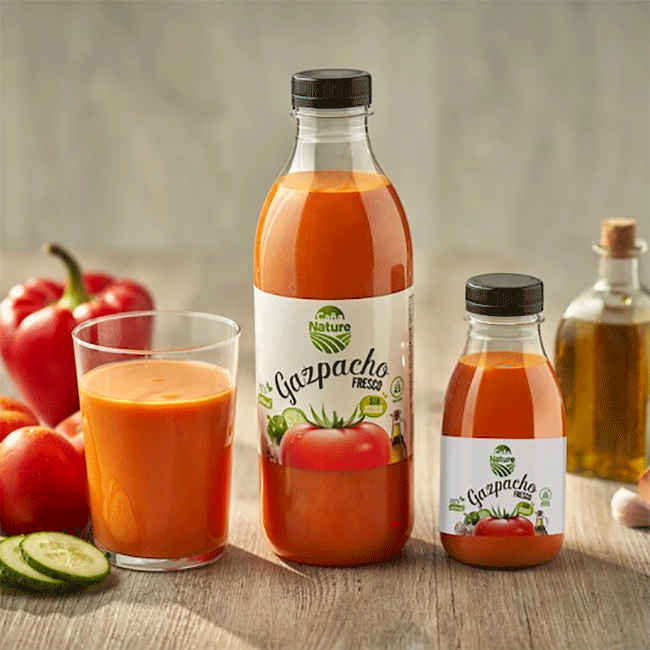.png.transform/rendition-xs/image_image%20(1).png)
The Cold Comfort of Gazpacho, the Spain’s Signature Soup
A beloved dish made to a 500-year-old recipe, chilled gazpacho soup is no longer just a seasonal, regional delicacy but a major national and natural resource with ever-growing export potential.

Summer in Spain brings with it gallons of gazpacho soup. Served refreshingly cold and traditionally classified as a kind of salad, it has been a particular delicacy in Andalusia since the 16th century, when colonial merchant ships returned to the ports of Cádiz and Motril with tomatoes and green peppers from the New World. Those crops would become essential to Iberian cuisine, and vital ingredients of gazpacho as a regional and national dish.
As a measure of how emblematic this soup is in the south of the country, consider the record-breaking gazpacho made there in summer 2019. Intended to celebrate the 10th anniversary of Andalusian farming cooperative the Unica Group, and to promote the city of Almería as “the capital of Spanish and European agriculture” (as mayor Ramón Fernández Pacheco put it), the attempt amounted to a downpour of almost 10,000 litres of gazpacho at the edge of the Tabernas desert, made with 6,000 kilos of tomatoes and 550 litres of Spanish olive oil.
One year later, in June 2020, the widely beloved gazpacho brand Alvalle opened a new state-of-the-art factory for its product in Alcantarilla, Murcia. Paid for by owners PepsiCo, the €31 million plant sources its tomatoes, peppers, cucumbers, and onions from the surrounding fields of Murcia, processing them on three eco-friendly production lines into ready-to-eat packages. A record-breaker in itself, the facility will turn out some 25 million litres of gazpacho this summer, more than half of it destined for Alvalle’s growing markets in France, Belgium, Portugal, Germany, Holland, and the UK, with PepsiCo also looking further afield to China and the US.

Awareness, and demand, have reached a point where the international market can also sustain smaller, specialized ventures such as La Caña Nature, whose ready-made soups are a relatively recent addition to the portfolio of parent company Grupo Caña Nature, a producer and exporter of fruits and vegetables from the Granada coast since 1978. Emerging from a strong corporate culture of research and development, the brand’s gazpacho soup has only been on the shelves since early 2020, but has already made a virtue of blending “tradition and innovation”, according to marketing director Marta Jiménez.
What this means in practical terms is drawing on fresh produce from associated farmers at the foot of the Sierra Nevada range – a UNESCO-protected Biosphere Reserve – and using those raw materials to their best effect by way of a process known as high-pressure cold-processing. Some competitors use high quantities of vinegar to help preserve their product, affecting the flavour to the point that many chefs and other “purists” complain that ready-made gazpacho does not always taste like the real thing. But La Caña Nature’s method, says Jiménez, uses no additives or preservatives even while “allowing us to increase the shelf life of the product up to seven weeks, so we can buy in larger quantities without the need for it to be consumed in a short time at point of purchase.” This is a major advantage in terms of export, though seven weeks is still such a short time as to make transport and sale “more complex” outside Europe.

But the key factor, says Jiménez, is that cold-processing “preserves all the properties of the soup’s fresh ingredients.” Present trends in food culture put so much emphasis on the natural and unadulterated, that gazpacho is primed for rediscovery along these lines, and this has already proven a major selling point for La Caña Nature’s recipe.
Pepper, tomato, garlic, mineral salts and other such vital, natural ingredients are so rich in vitamins and antioxidants as to help with everything from hydration to blood pressure to immune-system responsiveness, not to mention the cosmetic effects of ageing – Jiménez suggests that gazpacho constitutes “a tastier formula against wrinkles”. And while this soup has long been considered a summer product – produced, sold, and consumed in the warmest months – La Caña Nature is hoping that those health-giving, energy-boosting properties will further the company’s goal making gazpacho a product for all seasons.
Which is, in turn, the key to the export market, as many countries outwith the Mediterranean region are so much cooler year-round that soup is conversely a “winter” food and eating it cold is an unfamiliar concept. Or, at least, it was. As more tourists from further afield come to visit Spain, and more consumers come to understand Spanish cuisine through recipe books and cooking shows, and the Mediterranean diet itself has attained the status of Intangible Heritage of Humanity, as designated by UNESCO, the “cold character” of gazpacho becomes ever less of a barrier to trying it, and loving it. The energy that goes into it, and comes out it it, says Jiménez, is much more important than its temperature.
Text: Stephen Phelan

